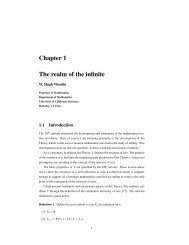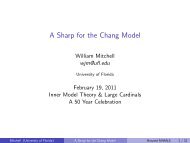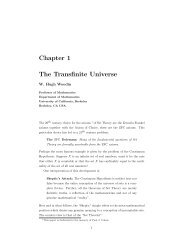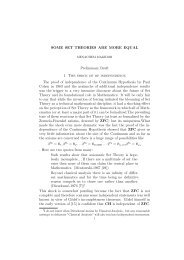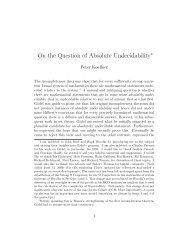The Continuum Hypothesis - Logic at Harvard
The Continuum Hypothesis - Logic at Harvard
The Continuum Hypothesis - Logic at Harvard
You also want an ePaper? Increase the reach of your titles
YUMPU automatically turns print PDFs into web optimized ePapers that Google loves.
and Determinacy”, which contains a general discussion of the independenceresults, the n<strong>at</strong>ure of axioms, the n<strong>at</strong>ure of justific<strong>at</strong>ion, and the successes oflarge cardinal axioms in the realm “below CH”. Second, we have not beenabletodiscuss everyapproachtoCHth<strong>at</strong>isintheliter<strong>at</strong>ure. Insteadwehaverestricted ourselves to those approaches th<strong>at</strong> appear most promising from aphilosophical point of view and where the m<strong>at</strong>hem<strong>at</strong>ics has been developedto a sufficiently advanced st<strong>at</strong>e. In the approaches we shall discuss—forcingaxioms, inner modeltheory, quasi-largecardinals—them<strong>at</strong>hem<strong>at</strong>icshasbeenpressed to a very advanced stage over the course of 40 years. And this hasmade our task somewh<strong>at</strong> difficult. We have tried to keep the discussion asaccessible as possible and we have placed the more technical items in theendnotes. But the reader should bear in mind th<strong>at</strong> we are presenting a bird’seye view and th<strong>at</strong> for a higher resolution <strong>at</strong> any point the reader should dipinto the suggested readings th<strong>at</strong> appear <strong>at</strong> the end of each section. 2<strong>The</strong>re are really two kinds of approaches to new axioms—the local approachand the global approach. On the local approach one seeks axiomsth<strong>at</strong> answer questions concerning a specifiable fragment of the universe, suchas V ω+1 or V ω+2 , where CH lies. On the global approach one seeks axiomsth<strong>at</strong> <strong>at</strong>tempt to illumin<strong>at</strong>e the entire structure of the universe of sets. <strong>The</strong>global approach is clearly much more challenging. In this entry we shall startwith the local approach and toward the end we shall briefly touch upon theglobal approach.Here is an overview of the entry: Section 1 surveys the independenceresults in cardinal arithmetic, covering both the case of regular cardinals(where CH lies) and singular cardinals. Section 2 considers approaches toCH where one successively verifies a hierarchy of approxim<strong>at</strong>ions to CH, eachof which is an “effective” version of CH. This approach led to the remarkablediscovery of Woodin th<strong>at</strong> it is possible (in the presence of large cardinals)to have an effective failure of CH, thereby showing, th<strong>at</strong> the effective failureof CH is as intractable (with respect to large cardinal axioms) as CH itself.Section 3 continues with the developments th<strong>at</strong> stemmed from this discovery.<strong>The</strong> centerpiece of the discussion is the discovery of a “canonical” model inwhich CH fails. This formed the basis of a network of results th<strong>at</strong> wascollectively presented by Woodin as a case for the failure of CH. To present2 We have of necessity presupposed much in the way of set theory. <strong>The</strong> reader seekingadditional detail—for example, the definitions of regular and singular cardinals and otherfundamental notions—is directed to one of the many excellent texts in set theory, forexample Jech (2003).3





